|
MAGNETIC FUSION: SIMULATION AND THEORY
L-H Transition and Tokamaks
Antonsen,
Dorland,
Drake,
Hassam
The tokamak is the primary device which has the potential for achieving thermonuclear fusion in a controlled environment. Over the last decade, very significant advances have been made on this device. New, improved modes of confinement have been found which have profound implications in the design of fusion reactors. A first principles understanding of the cause of these improved modes of confinement has been one of the major areas of research being pursued by the Theory Group at the University of Maryland.
The first mode of improvement in confinement, observed on devices all over the world, is the so-called L-H transition. In a tokamak heated by a neutral beam to achieve high plasma temperatures, the preliminary results were discouraging. It was observed that as the neutral beam power was increased, the particle and energy confinement times decreased. This mode of operation of the tokamak was referred to as the low (L) mode. This did not bode well for achieving the goals of thermonuclear fusion. However, with the further increase in input power, the discharge made a dramatic transition to a good confined mode, the high (H) mode. The improvement in confinement has been attributed to the generation of shear flow in the edge region of tokamaks, which creates a transport barrier.
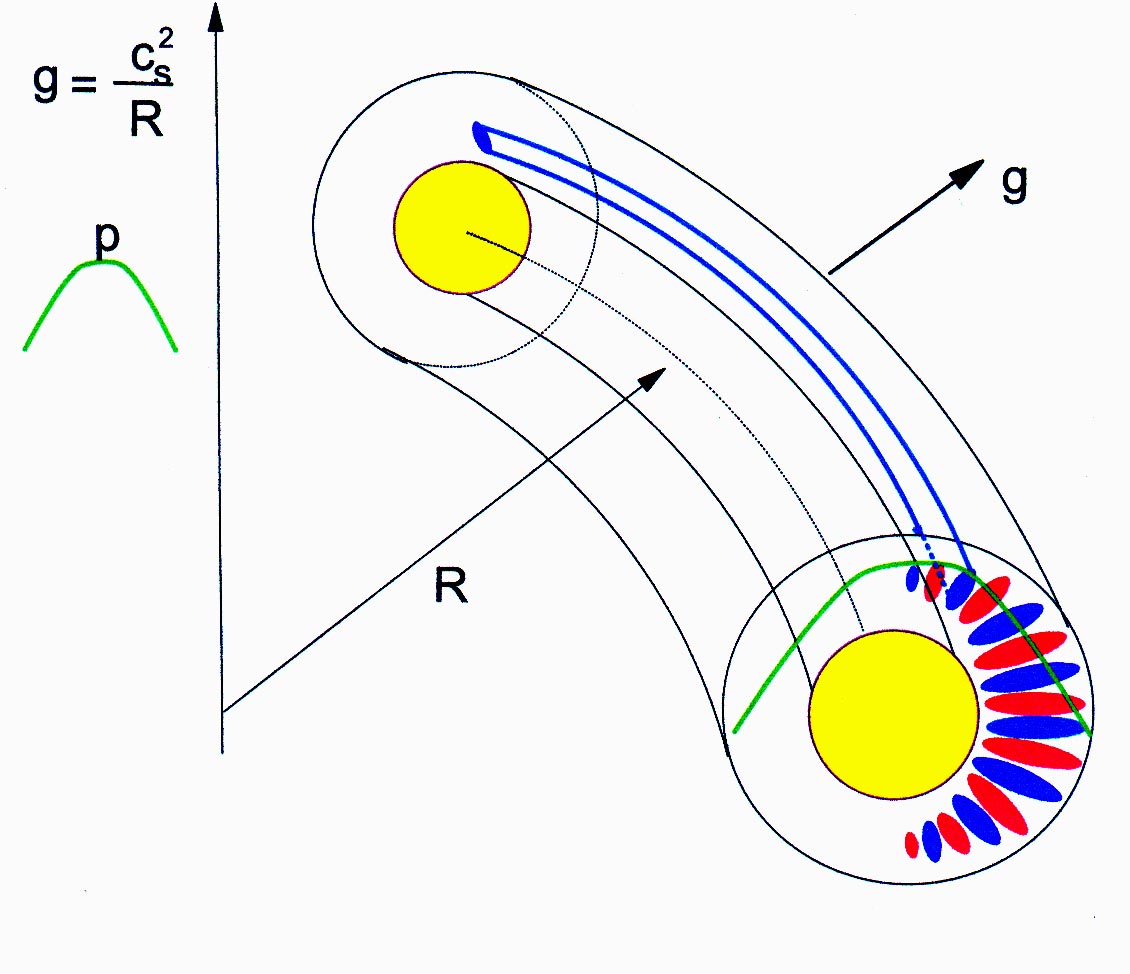 The Maryland Theory Group has made significant contributions in two areas relevant to the understanding of the L-H transition. By doing detailed 3D simulations of the edge region of the plasma, which have progressively been refined over the last few years, the cause of the anomalous transport, which lead to the poor confinement in the L mode phase, has been identified. The edge is prone to short scalelength convection due to the effective gravity arising from the toroidal curvature of the field lines. The pressure gradient and the gravity on the outside are unfavorable for stability. On the other hand, the pressure gradient on the inside is reversed and the plasma is stable. Thus this "ballooning" instability leads to enhanced particle and energy transport. The strong asymmetry in the transport is an important consequence of the theory, directly verified on some tokamaks which have the necessary diagnostics to measure the transport and fluctuations around the poloidal periphery.
The Maryland Theory Group has made significant contributions in two areas relevant to the understanding of the L-H transition. By doing detailed 3D simulations of the edge region of the plasma, which have progressively been refined over the last few years, the cause of the anomalous transport, which lead to the poor confinement in the L mode phase, has been identified. The edge is prone to short scalelength convection due to the effective gravity arising from the toroidal curvature of the field lines. The pressure gradient and the gravity on the outside are unfavorable for stability. On the other hand, the pressure gradient on the inside is reversed and the plasma is stable. Thus this "ballooning" instability leads to enhanced particle and energy transport. The strong asymmetry in the transport is an important consequence of the theory, directly verified on some tokamaks which have the necessary diagnostics to measure the transport and fluctuations around the poloidal periphery.
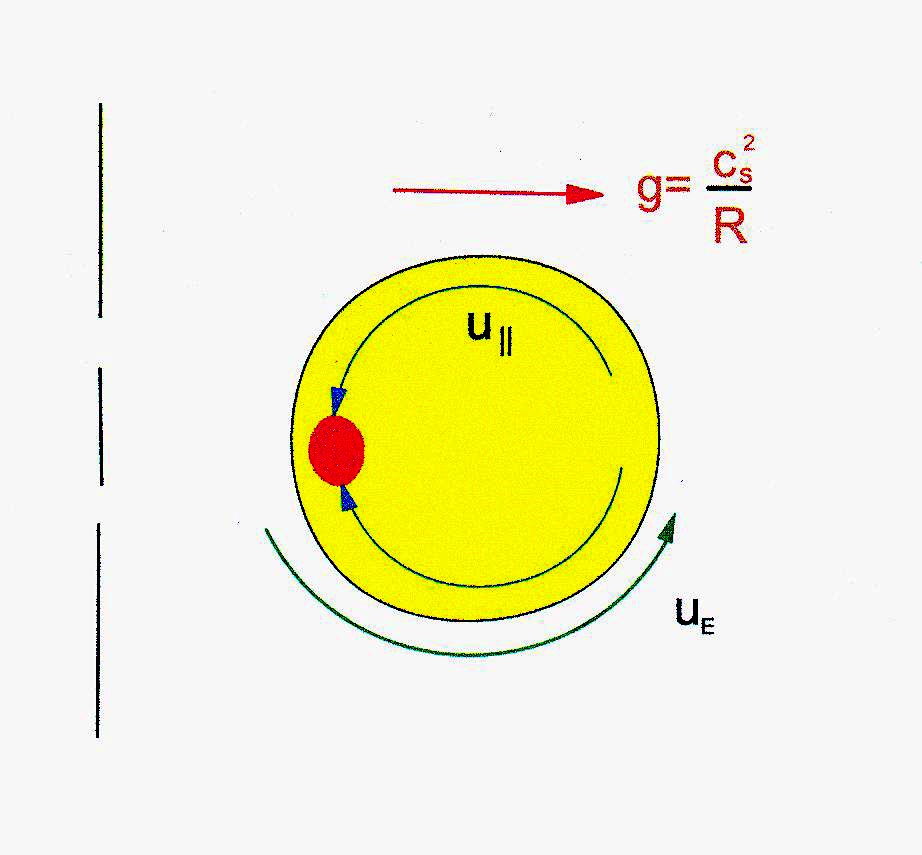 Another area related to the L-H transition problem is to develop an understanding of the generation of shear flow. Here again the Theory Group at Maryland has advanced a very plausible scenario to explain why the edge spins up when the temperature exceeds a critical temperature. The second figure shows that, due to asymmetric transport, the density varies on the magnetic flux surface. The local enhancement of the density on the inside (depicted by a blob) has a tendency to "fall" under the influence of the effective gravity. However, there are dissipative effects which dampen the fall. As the temperature increases, the damping weakens and the fall causes the blob to spin around in the poloidal direction. This spin-up confined to the edge strongly suppresses the ballooning, thereby giving rise to a transport barrier which improves the confinement. This research has led to a proposed scenario in which the spin-up is induced by neutral beams, thereby facilitating the onset of improved confinement.
Another area related to the L-H transition problem is to develop an understanding of the generation of shear flow. Here again the Theory Group at Maryland has advanced a very plausible scenario to explain why the edge spins up when the temperature exceeds a critical temperature. The second figure shows that, due to asymmetric transport, the density varies on the magnetic flux surface. The local enhancement of the density on the inside (depicted by a blob) has a tendency to "fall" under the influence of the effective gravity. However, there are dissipative effects which dampen the fall. As the temperature increases, the damping weakens and the fall causes the blob to spin around in the poloidal direction. This spin-up confined to the edge strongly suppresses the ballooning, thereby giving rise to a transport barrier which improves the confinement. This research has led to a proposed scenario in which the spin-up is induced by neutral beams, thereby facilitating the onset of improved confinement.
Another possible mechanism for transport barrier formation is also being pursued by members of the Theory Group, based on recent results from 3-D numerical simulations of edge turbulence in the presence of a fueling source. In response to the fueling, the edge plasma gradients in the simulation tend to steepen. This normally leads to an intensification of turbulence and a corresponding increase in the transport of particles and heat, thereby allowing the system to come into a new equilibrium with the source. In regimes of higher temperature (specifically, regimes of high MHD ballooning parameter a), however, the simulations show this dependence of the transport on the gradient can become reversed, making it impossible for such an equilibrium to be maintained. The result is a spontaneous steepening of the gradients that resembles the LH transition.
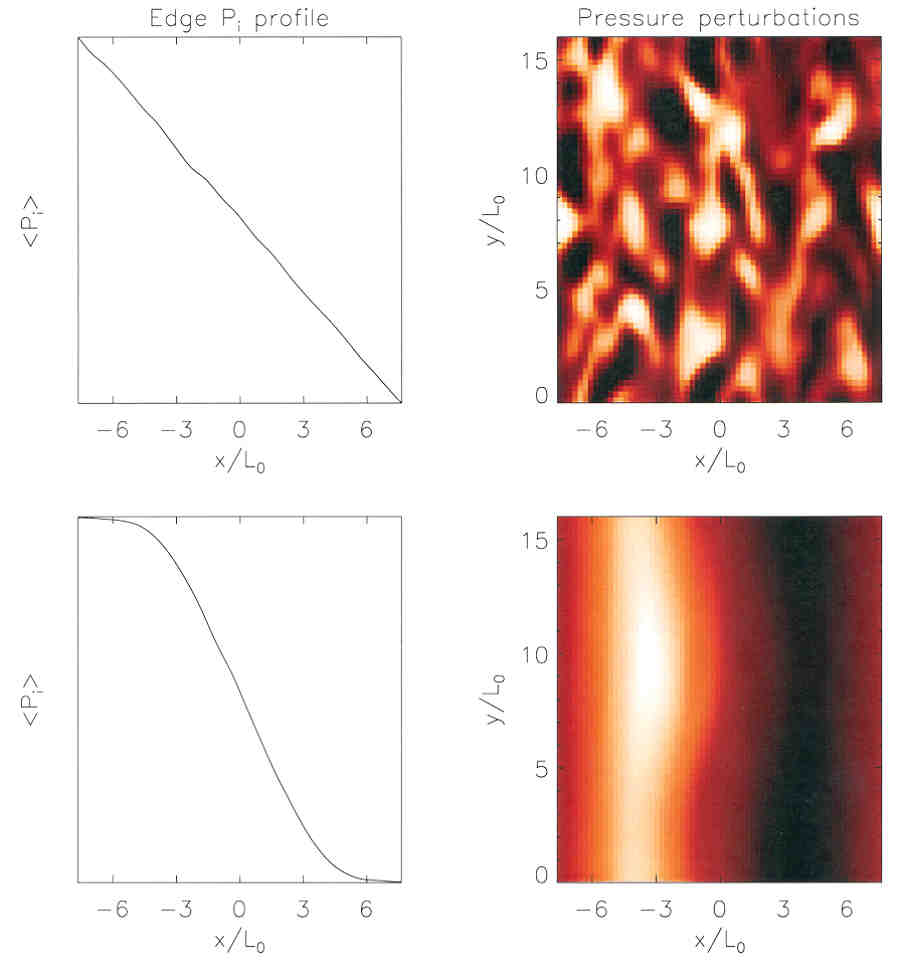
3-D Simulation of L/H Transition and Edge Pedestal
Another area of research in which the group plays a significant role is addressing the issues of magnetohydrodynamic (MHD) stability of high density and high temperature reactor-relevant plasmas. Achieving high density in the tokamak is important for making fusion power a commercially viable alternative. Such plasmas tend to develop equilibrium pressure and current profiles very different from present-day devices. The members of the Plasma Theory Group here have developed efficient numerical codes which can readily address these important issues. Results from the group indicate that some of the proposed high density equilibria may be violently unstable to a class of MHD modes which are not present in present-day low density devices.
This research is supported by the U.S. Department of Energy.
b Limit Disruptions in Tokamaks
Kleva, Guzdar
The most serious impediment to the practical utilization of tokamaks
as fusion reactors is the limitation on the plasma thermal pressure
imposed by disruptions. The ratio b of the thermal pressure to
the pressure of the confining magnetic field provides a measure of the
efficiency of a magnetic confinement fusion reactor. Operation at high
b is very desirable because it yields a large fusion reaction
rate relative to the cost of the confining magnetic field. However,
experimental attempts to increase the ratio b beyond a critical
limit bc have been thwarted by an abrupt, catastrophic loss of
confinement. Not only do these disruptions limit b and,
therefore, limit the efficiency of a tokamak, but the disruptions
themselves can cause serious damage to the reactor. Displayed below are results from 3D MHD simulations performed on the T3E machine at NERSC.
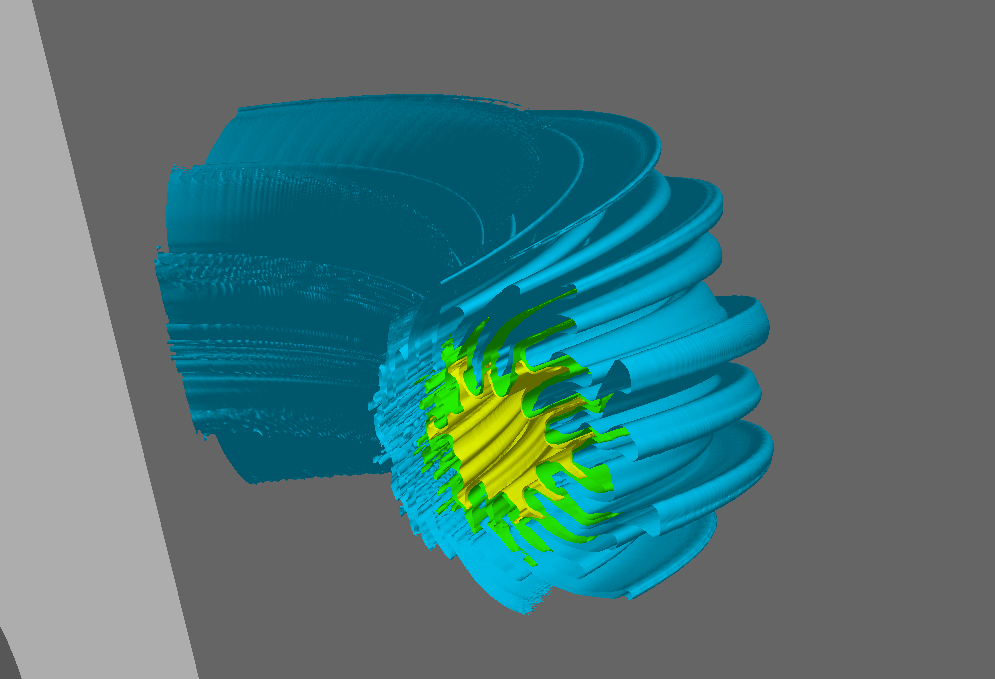 The figure above shows three-dimensional isosurfaces of the pressure as the instability develops along ridges dominantly aligned along the ambient magnetic field.
The figure above shows three-dimensional isosurfaces of the pressure as the instability develops along ridges dominantly aligned along the ambient magnetic field.
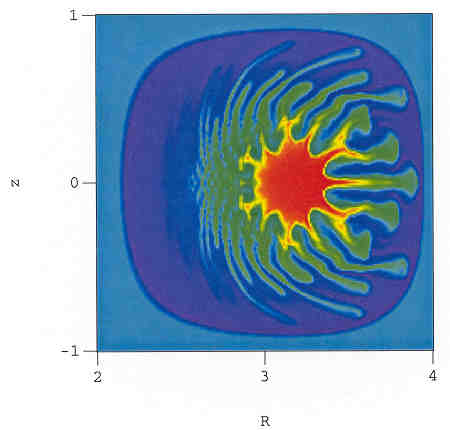 The figure on the right is a poloidal projection of the pressure that shows the hot plasma fingers as they reach the wall. Our nonlinear simulations of tokamak stability reproduce the salient
features of the disruptive loss of confinement. High b toroidal
equilibria are linearly unstable to ballooning modes that grow on the
pressure gradient on the large R side of the magnetic axis, where
R is the major radius of the torus. The convection cells associated
with the unstable ballooning modes transport the thermal energy toward
the wall at large R in hot plasma ridges whose two-dimensional
projection in the poloidal plane resembles fingers. As the hot central
plasma is transported out in R in fingers, the average pressure
gradient is reduced so that it no longer completely balances the
Lorentz force of the confining magnetic field. As a result, there is a
small net inward force in R caused by the unbalanced Lorentz
force. At lower bthis force generates an axisymmetric flow
that opposes the growth of the fingers to the wall at large R,
thereby stabilizing the plasma nonlinearly and maintaining
confinement. However, as b increases the growth rate of the
plasma fingers towards the wall becomes so rapid that there is
insufficient time for the self-consistently generated axisymmetric
flow to halt their progress before they strike the wall, and
confinement is lost.
The figure on the right is a poloidal projection of the pressure that shows the hot plasma fingers as they reach the wall. Our nonlinear simulations of tokamak stability reproduce the salient
features of the disruptive loss of confinement. High b toroidal
equilibria are linearly unstable to ballooning modes that grow on the
pressure gradient on the large R side of the magnetic axis, where
R is the major radius of the torus. The convection cells associated
with the unstable ballooning modes transport the thermal energy toward
the wall at large R in hot plasma ridges whose two-dimensional
projection in the poloidal plane resembles fingers. As the hot central
plasma is transported out in R in fingers, the average pressure
gradient is reduced so that it no longer completely balances the
Lorentz force of the confining magnetic field. As a result, there is a
small net inward force in R caused by the unbalanced Lorentz
force. At lower bthis force generates an axisymmetric flow
that opposes the growth of the fingers to the wall at large R,
thereby stabilizing the plasma nonlinearly and maintaining
confinement. However, as b increases the growth rate of the
plasma fingers towards the wall becomes so rapid that there is
insufficient time for the self-consistently generated axisymmetric
flow to halt their progress before they strike the wall, and
confinement is lost.
This research is supported by the U.S. Department of Energy.
|


 The Maryland Theory Group has made significant contributions in two areas relevant to the understanding of the L-H transition. By doing detailed 3D simulations of the edge region of the plasma, which have progressively been refined over the last few years, the cause of the anomalous transport, which lead to the poor confinement in the L mode phase, has been identified. The edge is prone to short scalelength convection due to the effective gravity arising from the toroidal curvature of the field lines. The pressure gradient and the gravity on the outside are unfavorable for stability. On the other hand, the pressure gradient on the inside is reversed and the plasma is stable. Thus this "ballooning" instability leads to enhanced particle and energy transport. The strong asymmetry in the transport is an important consequence of the theory, directly verified on some tokamaks which have the necessary diagnostics to measure the transport and fluctuations around the poloidal periphery.
The Maryland Theory Group has made significant contributions in two areas relevant to the understanding of the L-H transition. By doing detailed 3D simulations of the edge region of the plasma, which have progressively been refined over the last few years, the cause of the anomalous transport, which lead to the poor confinement in the L mode phase, has been identified. The edge is prone to short scalelength convection due to the effective gravity arising from the toroidal curvature of the field lines. The pressure gradient and the gravity on the outside are unfavorable for stability. On the other hand, the pressure gradient on the inside is reversed and the plasma is stable. Thus this "ballooning" instability leads to enhanced particle and energy transport. The strong asymmetry in the transport is an important consequence of the theory, directly verified on some tokamaks which have the necessary diagnostics to measure the transport and fluctuations around the poloidal periphery. Another area related to the L-H transition problem is to develop an understanding of the generation of shear flow. Here again the Theory Group at Maryland has advanced a very plausible scenario to explain why the edge spins up when the temperature exceeds a critical temperature. The second figure shows that, due to asymmetric transport, the density varies on the magnetic flux surface. The local enhancement of the density on the inside (depicted by a blob) has a tendency to "fall" under the influence of the effective gravity. However, there are dissipative effects which dampen the fall. As the temperature increases, the damping weakens and the fall causes the blob to spin around in the poloidal direction. This spin-up confined to the edge strongly suppresses the ballooning, thereby giving rise to a transport barrier which improves the confinement. This research has led to a proposed scenario in which the spin-up is induced by neutral beams, thereby facilitating the onset of improved confinement.
Another area related to the L-H transition problem is to develop an understanding of the generation of shear flow. Here again the Theory Group at Maryland has advanced a very plausible scenario to explain why the edge spins up when the temperature exceeds a critical temperature. The second figure shows that, due to asymmetric transport, the density varies on the magnetic flux surface. The local enhancement of the density on the inside (depicted by a blob) has a tendency to "fall" under the influence of the effective gravity. However, there are dissipative effects which dampen the fall. As the temperature increases, the damping weakens and the fall causes the blob to spin around in the poloidal direction. This spin-up confined to the edge strongly suppresses the ballooning, thereby giving rise to a transport barrier which improves the confinement. This research has led to a proposed scenario in which the spin-up is induced by neutral beams, thereby facilitating the onset of improved confinement.
 The figure on the right is a poloidal projection of the pressure that shows the hot plasma fingers as they reach the wall. Our nonlinear simulations of tokamak stability reproduce the salient
features of the disruptive loss of confinement. High b toroidal
equilibria are linearly unstable to ballooning modes that grow on the
pressure gradient on the large R side of the magnetic axis, where
R is the major radius of the torus. The convection cells associated
with the unstable ballooning modes transport the thermal energy toward
the wall at large R in hot plasma ridges whose two-dimensional
projection in the poloidal plane resembles fingers. As the hot central
plasma is transported out in R in fingers, the average pressure
gradient is reduced so that it no longer completely balances the
Lorentz force of the confining magnetic field. As a result, there is a
small net inward force in R caused by the unbalanced Lorentz
force. At lower bthis force generates an axisymmetric flow
that opposes the growth of the fingers to the wall at large R,
thereby stabilizing the plasma nonlinearly and maintaining
confinement. However, as b increases the growth rate of the
plasma fingers towards the wall becomes so rapid that there is
insufficient time for the self-consistently generated axisymmetric
flow to halt their progress before they strike the wall, and
confinement is lost.
The figure on the right is a poloidal projection of the pressure that shows the hot plasma fingers as they reach the wall. Our nonlinear simulations of tokamak stability reproduce the salient
features of the disruptive loss of confinement. High b toroidal
equilibria are linearly unstable to ballooning modes that grow on the
pressure gradient on the large R side of the magnetic axis, where
R is the major radius of the torus. The convection cells associated
with the unstable ballooning modes transport the thermal energy toward
the wall at large R in hot plasma ridges whose two-dimensional
projection in the poloidal plane resembles fingers. As the hot central
plasma is transported out in R in fingers, the average pressure
gradient is reduced so that it no longer completely balances the
Lorentz force of the confining magnetic field. As a result, there is a
small net inward force in R caused by the unbalanced Lorentz
force. At lower bthis force generates an axisymmetric flow
that opposes the growth of the fingers to the wall at large R,
thereby stabilizing the plasma nonlinearly and maintaining
confinement. However, as b increases the growth rate of the
plasma fingers towards the wall becomes so rapid that there is
insufficient time for the self-consistently generated axisymmetric
flow to halt their progress before they strike the wall, and
confinement is lost.